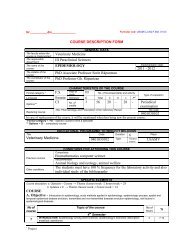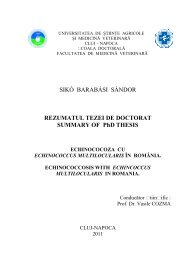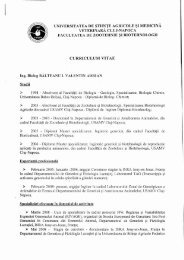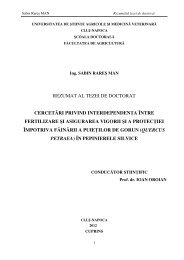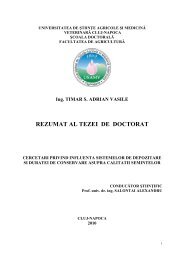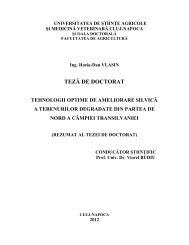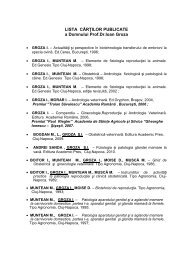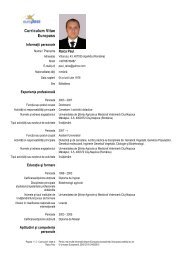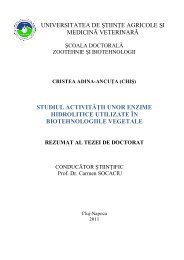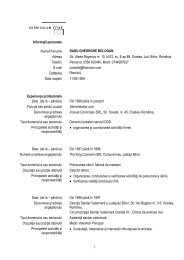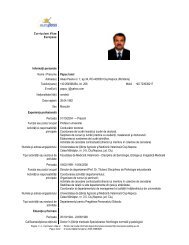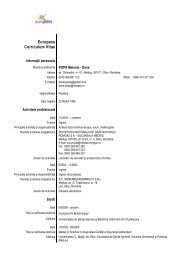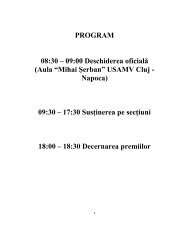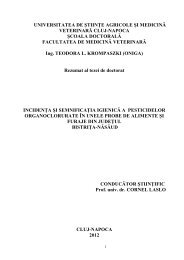self evaluation report - Universitatea de Ştiinţe Agricole şi Medicină ...
self evaluation report - Universitatea de Ştiinţe Agricole şi Medicină ...
self evaluation report - Universitatea de Ştiinţe Agricole şi Medicină ...
You also want an ePaper? Increase the reach of your titles
YUMPU automatically turns print PDFs into web optimized ePapers that Google loves.
and case studies are not always as results of practical activities carried out during the stu<strong>de</strong>nts’ practical<br />
activity.<br />
5. Research weaknesses: Lack of full-time research staff; small number of European projects, low ratios<br />
between the number of teachers and ISI publications, and small number of inventions and patents; Small<br />
number of Master and PhD stu<strong>de</strong>nts involved in research projects and contracts.<br />
6. Low efficiency of technology transfer of the research results (with low financial incomes), into the real<br />
economic environment; No organizational structure at the university level handle the technology transfer,<br />
consulting, outsourcing;<br />
7. Insufficient visibility: Small number of interdisciplinary, transdisciplinary research with other universities in<br />
Cluj-Napoca, other USAMV in the country, and EU universities;<br />
8. Decreasing number of exchanges via Erasmus programs (teachers and stu<strong>de</strong>nts, from and to Romania)<br />
9. Limited information on the labor market needs and on the graduates’ career track, poor involvement of<br />
the ALUMNI Association.<br />
10. Deficiencies in the management and attitu<strong>de</strong> of administration services: need for training, procedures’<br />
follow-up, and quality assessments<br />
OPPORTUNITIES<br />
1. The USAMVCJ classification among the "first class" category is a good pre-requisite for additional funding<br />
in education and research;<br />
2. Development of new collaborative networks and partnerships with foreign universities;<br />
3. Accessing specific grants for stu<strong>de</strong>nt practice;<br />
4. Collaboration with the economic environment for possible technology transfers, service offerings,<br />
consulting;<br />
5. The interest of young people from different countries and from outsi<strong>de</strong> the European space for the<br />
un<strong>de</strong>rgraduate and master educational programmes we offer.<br />
6. Valorization of HORIZON 2020 strategy to encourage and support University research programs<br />
7. Allocation of significant financial support by the new Common Agricultural Policy, to finance the specific<br />
innovation programs in agriculture and farm-level transfer;<br />
8. Development of new European programmes type "Long Life Learning” and E-Platforms<br />
9. Development of new National priority programs, e.g. human resources improvement, regional technology<br />
parks, poles of competitiveness ,<br />
10. Development of existing partnerships with public institutions and the private sector, generating new<br />
sources of funding.<br />
THREATS<br />
1. The Governmental financing for higher education and research <strong>de</strong>creasing in the past year may result in<br />
insufficient funds for the aca<strong>de</strong>mic processes. The answer of the university consists of a permanent<br />
struggle to increase the efficiency of these processes, while maintaining or increasing quality, and by<br />
<strong>de</strong>veloping specific activities for attracting founds, valorizing the resources (lifelong learning programs,<br />
RTD projects financed at national or EU level, RTD projects and research services <strong>de</strong>veloped for<br />
companies).<br />
2. National and international competition: open competition for attracting stu<strong>de</strong>nts, quality resources and<br />
founds. The university’s answer is in the permanent effort for increasing the quality of the educational and<br />
training offer, in launching new study programs requested by the labor market, in <strong>de</strong>veloping research<br />
programs, and attractive, high-level programs, for advanced human resources training. The aggressive<br />
policy of the important universities in attracting graduate stu<strong>de</strong>nts and post doctoral stu<strong>de</strong>nts;<br />
Competition from other universities through ten<strong>de</strong>r based on the more <strong>de</strong>veloped material,<br />
accommodation, sports facilities, sponsorship;<br />
3. The National legislation which is not (yet) highly stimulating for attracting foreign stu<strong>de</strong>nts (outsi<strong>de</strong> EU).<br />
The national legislation also raise threats related to the crisis measures which strongly limit new<br />
employment within budgetary institutions. Short term measures to counterbalance this threat are<br />
possible by increasing the efficient use of the existent resources.<br />
Page 23 SELF-EVALUATION REPORT, March, 2012



